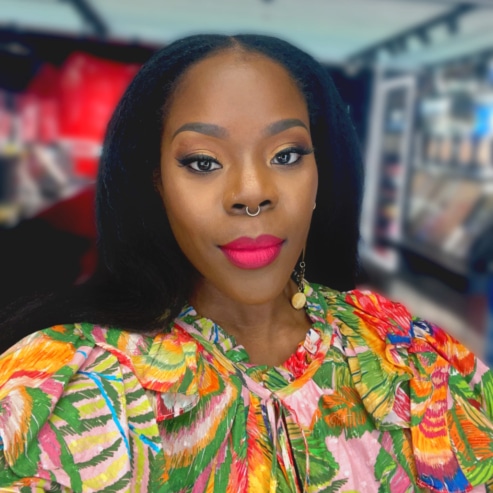Kezia Israel is an award-winning marketer and a LinkedIn Community Top Voice with over 18 years of experience in the creative field. Kezia’s saucy yet sweet personality produces messaging with attitude and meaning. Her transition from visual to verbal branding gives her a multidisciplinary perspective. She’s the strategic thinker who pioneered the Six Thinking Pens™ process.
Exactly How To Nail Your Brand Voice With Kizkopop

The most successful social media profiles—the ones you must immediately follow and keep coming back to—are the ones that just seem to “get” you. Their content reaches into your soul, reads your brain, and makes you laugh while you DM it to your friends and coworkers saying, “it me.”
It feels natural. Effortless. Deeply personal, even. And that is the outcome of a strong, effective brand voice.
Whether you’re a Marketer or a Creator, a clear verbal identity has the power to express your brand and personality, and connect more deeply with your audience. So we spoke to Kezia Israel, a Verbal Identity Strategist known as Kizkopop, who shared her top tips for crafting and nailing a unique, impactful verbal identity.
The Importance of a Strong, Clear Verbal Identity for Brands and Creators
We know—“verbal identity” can sound like a term cooked up by a branding agency that spends six months researching whether Panera should use the word “rizz” in their TikTok videos. But your “verbal identity” is simply a term encapsulating your brand, voice, and tone. It’s a unique linguistic fingerprint that guides the ways you write, speak, and even approach creating content.
And while a clear brand voice can help you connect with your audience, it can also do so much more. According to Israel, “a solid verbal identity offers a consistent and recognizable voice, separates Creators or brands from competitors, fosters a sense of familiarity and loyalty among their audience, and enhances content engagement.”
Your brand voice can help you define who you are as a Creator. Maybe you’re seen as a beauty authority because of your confident, no-filter reviews of the best (and worst) products you’ve ever tried. Or your audience sees you as a relatable best friend from your hilarious, blisteringly real takes on modern dating.
For Creators aiming to become the next social media star, “a well-defined verbal identity is not just a nice-to-have—it’s necessary for building long-term partnerships and ensuring their message is heard, felt, and remembered,” Israel says.
How To Discover Your Verbal Identity
You don’t need to be a professional writer (or work at said aforementioned branding agency) to create a verbal identity. Remember, the most engaging Creators show up as themselves online—and that realness is what makes their copy, writing, and voiceovers resonate. So you just need a clear sense of your own brand, what you want to say, and how you want to say it.
Discovering your own voice means understanding what sets you apart, and how that makes you compelling to an audience. Maybe you love to crack jokes on social media. Or, you’re brutally honest with your audience about everything—your real life challenges, your failures, your personal stories.
If you’re not sure where to start, Israel provided these first steps for discovering your own unique voice:
- Identify your interests and passions: “What are your core values, passions, and the messages you want to share? Your unique voice will naturally emerge from the topics you’re most passionate about.”
- Find inspiration: “Think about the books, blogs, podcasts, or social media accounts you love. What draws you to them? Is it their humor, sincerity, depth, or style? Analyzing what resonates with you can help pinpoint elements you want to incorporate into your voice.”
- Establish the basics: “Understanding good writing fundamentals can help you communicate more effectively. While your voice should be unique, clarity, simplicity, and proper grammar are universally appreciated, making your message more accessible.”
- Just write: “Practice makes progress, so write often without worrying about perfection. Journaling, blogging, or even social media posting can be effective ways to practice and refine your voice. Over time, patterns will emerge that highlight your natural style and tone.”
- Use feedback wisely: “Share your writings with friends or a community of Creators. Feedback can provide insights into what aspects of your voice resonate most with others and where you can improve.”
- Try new things: “Don’t be afraid to experiment with different styles or tones in your writing. Playfulness can lead to discoveries about what feels most authentic and engaging to you and your audience.”
- Lean into your unique POV: Your life experiences, perspectives, and quirks make your voice unique. Embrace them in your writing to separate your voice from others.
Here Are 6 Ways To Connect With Your Audience Through Copy
Your verbal identity can help you cultivate a community who love relating to your personal stories, reading your interesting thoughts, or laughing at your hilarious videos. And this sense of community and relatability is what can help you grow your audience and engagement.
While there are a lot of ways to build an audience online, there are a few linguistic strategies that can help you better engage with your followers. In fact, Israel laid out six ideas for writing copy that builds connection:
- Write like your audience speaks: “Use the linguistic nuances, slang, and phrases your audience uses. Mirroring their language makes you relatable and fosters a sense of community and belonging.”
- Tell stories: “People are naturally drawn to them. Incorporating storytelling evokes emotions and makes complex topics digestible.”
- Be real: “Share your challenges and failures. Vulnerability makes your brand human.”
- Stay consistent: “Maintain the same brand voice across all platforms. Consistency builds trust over time, as your audience knows what to expect from your communication.”
- Start a conversation: “Make your communication a dialogue by actively engaging with your audience. Ask questions and solicit feedback to show that you value their opinions and experiences.”
- Personalize your message: “Whenever possible, tailor your messages to meet your audience’s needs, preferences, and behaviors. Personalization demonstrates your commitment to understanding and serving your audience as individuals.
Perfect Your Writing and Copy With These 5 Tips
Ready for the advanced course? Let’s go…
1. Focus on clear, precise writing that isn’t bogged down by jargon.
Always aim for your writing to be clear and precise. Simplify it whenever possible; often, you can probably find a bunch of filler words to be able to cut on another, second glance. A good rule of thumb is to write the way you speak, as if you’re having a conversation with a friend, and then you can always go back and edit for a more polished tone.
One way to water down your writing and alienate your audience? Overcomplicating your message with insider jargon. “Using jargon or attempting to sound overly ‘smart’ or ‘sophisticated’…often creates barriers to understanding, especially for individuals who may not be familiar with the specific terminology used,” says Israel. Instead of reaching out a hand to your audience, jargon creates a layer of separation.
Also, vague, jargon-heavy writing makes your message generic and muddled. Here’s an example courtesy of ChatGPT: “Leveraging agile frameworks enables a seamless ecosystem for optimizing cross-platform innovation, driving value-added synergies to empower stakeholder engagement in the digital journey.” You’re trying to say something, remember?
Not only can peppering your writing with phrases like “synergy” or “stakeholder” make your copy feel dry, but it can also “make you seem inaccessible or pretentious rather than inclusive,” Israel explains.
2. Embrace authenticity.
We talk about authenticity a lot. But that’s because authenticity is necessary for a personalized brand voice. Being yourself, being human, being relatable—these are the building blocks of connection.
“Authenticity highlights personality, and in a world saturated with content, authentic copy stands out by connecting with audiences, fostering trust, and building meaningful relationships,” says Israel. “Consumers are savvy and can quickly spot insincerity or generic messaging, making authenticity crucial in engaging and retaining attention.”
3. Lean into emotion and curiosity to craft your “hook.”
With social media’s drive toward short-form video, it’s never been more important to have a “hook” that immediately captures your audience’s attention. Your “hook” might be a tease of information, a controversial opinion, or the promise of a satisfying transformation.
But according to Israel, the best hooks “lead with a powerful emotion or are provocative.” To do this, she recommends “tapping into universal emotions such as curiosity, excitement, fear, anger, or joy [which] can instantly engage readers, making them want to explore further.” Israel also suggests leaning into “provocative hooks [that] pique curiosity and compel the audience to read on for the answer or explanation.”
4. Flex your tone for different platforms and audiences.
This may be a more advanced strategy, but the best brands and Creators know how to change their tone for different platforms and audiences. In fact, the Marketing team at Collective Voice flexes our tone to be more vibrant and cheeky on Instagram, but more buttoned-up on LinkedIn. To do this, “Marketers and Creators should thoroughly understand the nuanced environment and expectations of each channel and audience segment they speak to,” says Israel.
You can also switch up your writing for different mediums. “It’s also crucial to consider the content format,” Israel explains, “as a blog post might warrant a different tone than a quick social media update or a video.”
5. Stay away from cliches.
There’s a time and place for utilizing commonly-used sayings, trending social media lingo, or even a good pun. But according to Israel, overusing certain words can cause them to lose their impact and become clichés.
Opting for clear, specific, and unique messaging can make your voice even stronger. Says Israel, “retiring or creatively reimagining these phrases could help Creators stand out and communicate more effectively and authentically with their audience.”
Plus, “live, laugh, love” was so 2012.





